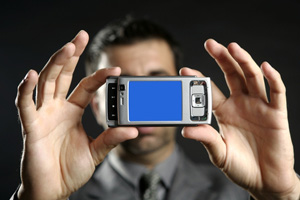THE burgeoning use of smartphones to take medical photos of patients has highlighted a growing problem of possibly illegal use of personal data and a lack of hospital policies to control it.
A Perspectives article in this week’s MJA says a “click first, care second” culture was developing because of a failure to properly manage the problem, which could lead to a “trampling of patients’ dignity”. (1)
The article, based on an honours thesis in which RMIT science student Kara Burns examined clinicians’ compliance with hospital consent policy when taking medical photographs, said the practice raised the “spectre of medical malpractice litigation”.
The authors highlighted issues of lack of proper consent, copyright problems and the lack of policies to cover the use of emerging technologies.
A medical photographer at one large tertiary hospital told MJA InSight he regularly witnessed staff taking photos of patients on their phones with no regard for the patient’s privacy or obtaining consent.
He cited one case where a patient who had suffered horrific injuries was photographed by several people while in the operating theatre under anaesthetic. The photographer was also aware of hospital staff being offered inducements by the media to use their phones to take photos of celebrities in hospital.
Although the hospital had a policy on taking photos and video images of patients, drafted by lawyers and circulated to all staff, the policy was not policed, the photographer said.
“People will only take this issue seriously if there is litigation”, he said.
Professor Paul Komesaroff, director of the Monash Centre for Ethics in Medicine and Society, said the mobile phone culture had turned the capture of visual images into a routine, commonplace event.
He said the issue went beyond mobile phone photos to the growing field of telemedicine, where the transmission of images was commonplace in some disciplines such as tele-dermatology.
“However, as the [MJA] authors point out, in the clinical setting, recording and sorting of such images could significantly compromise privacy and confidentiality”, said Professor Komesaroff, a practising physician and professor of medicine at Monash University.
The MJA authors wrote that digital cameras, especially those in smartphones, gave clinicians a high degree of autonomy to take medical photos.
“Photos taken by clinicians aid diagnosis and teaching, but no matter how well intentioned, clinicians who take medical photos have practical, legal and ethical issues to negotiate”, the authors wrote.
“As the distribution of electronic data through the internet, social media and mobile devices becomes easier, appropriate collection, consent and use of medical imagery is essential.”
Professor Komesaroff said it was a tradition of medicine that clinical information was shared among the scientific community, but any identifying data or information had to be removed or modified to protect patient privacy.
“There is no general prohibition against clinicians keeping their own records … so long as they maintain proper respect for their patients”, he said.
The MJA authors also warned that photos taken by clinicians in a hospital were owned by the health department.
However, lawyer Bill Madden, national practice group leader – medical law with Slater & Gordon, told MJA InSight that if an employee took a photo during the course of their employment, it would belong to the employer, but in many cases doctors were not employees but independent contractors.
“Ownership would then depend on express or implied terms in contracts”, Mr Madden said.
The position was also complicated by the fact that the image may be part of the medical record, Mr Madden said.
“A patient in giving consent for the photo can create terms as to its ownership, copyright, and use, in the same way that photographic models do. Ownership is not a black-and-white concept in this context.”
Mr Madden also advised doctors to keep privacy laws in mind. “The way a doctor keeps an image on their phone, sends it, shows it, etc, may breach the privacy principles and see them or the hospital get into trouble for not keeping a record secure”, he said.
– Kath Ryan
Posted 3 September 2012

 more_vert
more_vert